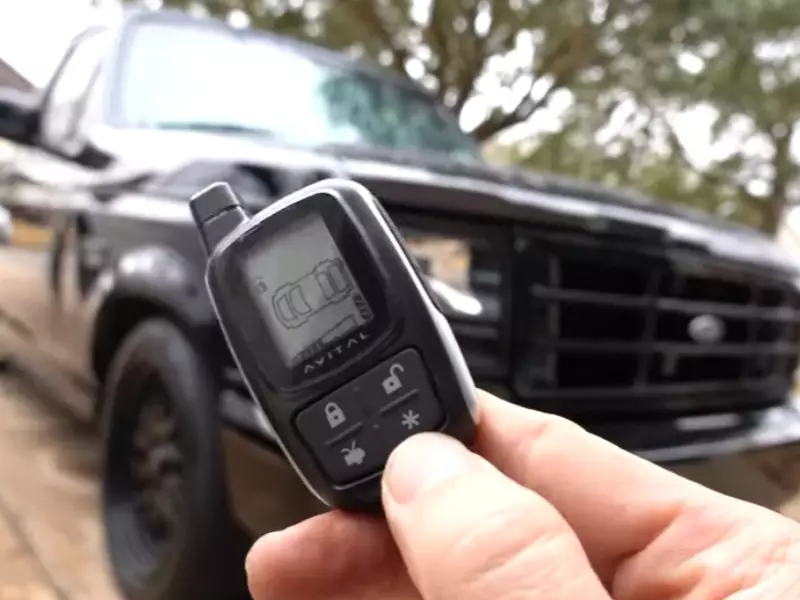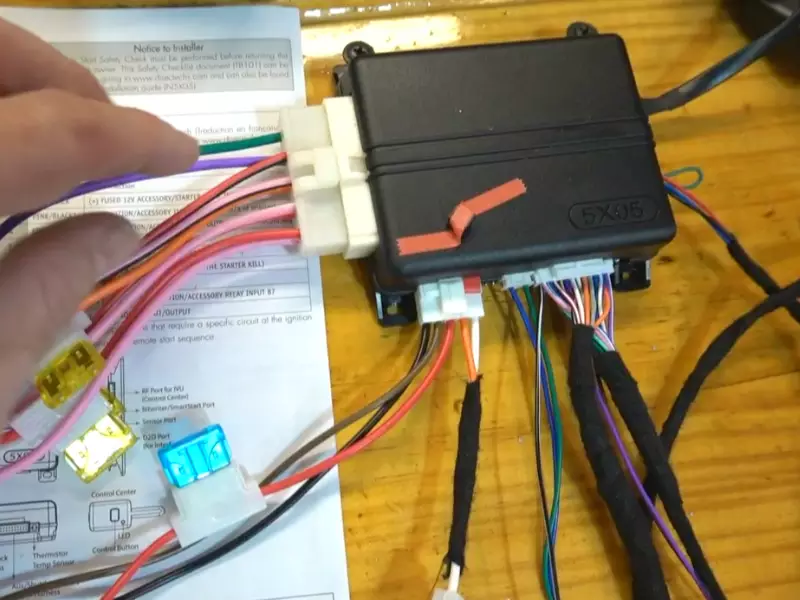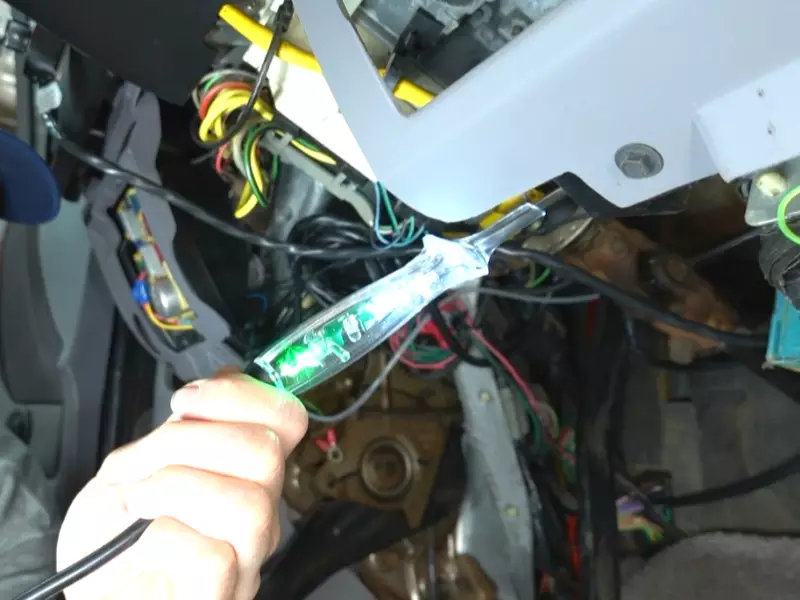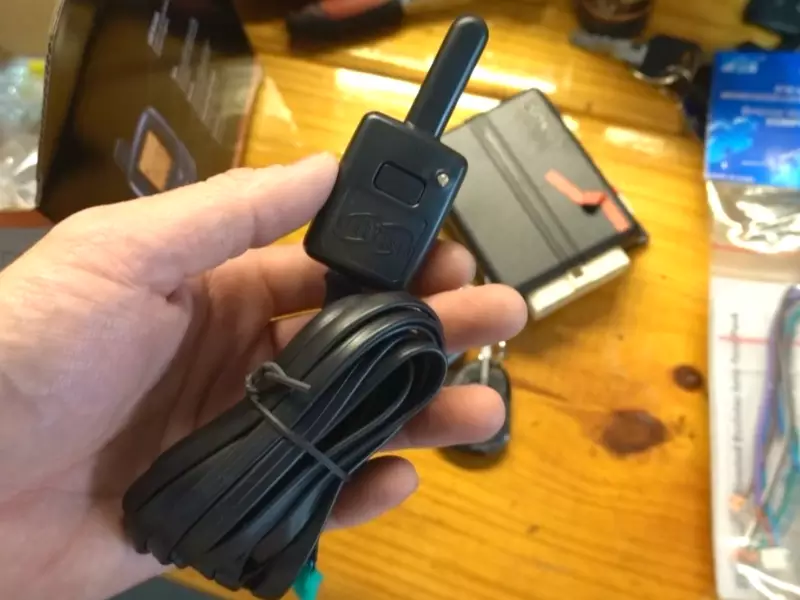To install a remote start alarm, consult the user manual for your specific alarm system or hire a professional installer. Remote start alarms offer convenience and enhanced security for your vehicle, allowing you to start the engine remotely and monitor your vehicle’s status from a distance.
Whether you want to warm up your car on a chilly morning or ensure its safety, installing a remote start alarm can be a valuable upgrade. However, to ensure proper installation and operation, it is important to follow the manufacturer’s instructions or hire an experienced installer.
This article will guide you through the process of installing a remote start alarm, providing essential tips and precautions to help you get it up and running smoothly.
Why Install A Remote Start Alarm System?
Installing a remote start alarm system in your vehicle is a smart choice that offers a range of benefits. Not only does it increase convenience and comfort, but it also improves vehicle security. Let’s delve deeper into why you should consider installing a remote start alarm system for your vehicle.

Increase Convenience and Comfort
One of the primary reasons to install a remote start alarm system is the added convenience and comfort it provides. With this system, you can start your vehicle from a distance, allowing it to warm up or cool down before you even step inside. No more sitting in a hot or cold car while waiting for it to reach a comfortable temperature. Simply use the remote start feature, and your vehicle will be ready for you when you are.
Additionally, remote start alarm systems often come with features like keyless entry and power trunk release, further enhancing the convenience factor. You can unlock your vehicle or open the trunk without fumbling for your keys or struggling with heavy loads. It’s a small change that can make a big difference in your daily routine.
Improve Vehicle Security
A remote start alarm system not only enhances convenience but also provides an added layer of security for your vehicle. With advanced security features like keyless entry and anti-theft systems, you can rest easy knowing that your vehicle is protected.
Keyless entry eliminates the need for physical keys, reducing the risk of theft or unauthorized access to your vehicle. Anti-theft systems will immobilize your vehicle if someone tries to start it without the proper authentication. These security measures help deter potential thieves and protect your valuable investment.
Besides, many remote start alarm systems offer additional security features like shock sensors and panic buttons. Shock sensors detect any sudden impact on your vehicle, triggering the alarm and alerting you to potential tampering or break-in attempts. Panic buttons provide an instant way to draw attention and scare off any potential threats in emergency situations.
Investing in a remote start alarm system is not only for convenience but also for providing peace of mind, knowing that your vehicle is protected and secure.
Benefits Of Installing Remote Start Alarm
Installing a remote start alarm in your vehicle offers a range of benefits that can greatly enhance your driving experience. Not only does it provide convenience, but it also improves safety and security. In this article, we will discuss the various advantages of installing a remote start alarm.
Start car remotely
One of the key benefits of installing a remote start alarm is the ability to start your car remotely. With just a push of a button on your remote, you can start your engine from a distance. This is particularly useful during those cold winter months when you want to warm up your vehicle before getting inside. You no longer need to endure the discomfort of sitting in a cold car or waiting for the engine to warm up. With remote start, you can have your car ready and waiting, with the perfect temperature, before you even step out of your house.

Precondition the cabin temperature
Another advantage of a remote start alarm is the ability to precondition the cabin temperature. When you start your car remotely, the heating or cooling system will activate, ensuring that the interior of your vehicle is at the desired temperature when you get in. This is especially beneficial during extreme weather conditions, allowing you to step into a comfortable environment and avoid any discomfort caused by the outside temperature.
Deter thieves
Installing a remote start alarm can act as a deterrent to potential thieves. When your car is equipped with a remote start system, it gives the impression that your vehicle is continuously monitored. This added layer of security makes thieves think twice before targeting your vehicle. Additionally, some remote start alarms come with anti-theft features such as immobilizers and alarm triggers, further enhancing the security of your vehicle.
Monitor vehicle status
Remote start alarms often have advanced features that allow you to monitor the status of your vehicle. With the help of a smartphone app or a remote control, you can check if your car is locked or unlocked, if the alarm is activated, or if any security alerts have been triggered. This offers peace of mind, especially when you have parked your vehicle in an unfamiliar location or in a high-crime area.
In conclusion, installing a remote start alarm not only provides convenience and comfort but also enhances the safety and security of your vehicle. With the ability to start your car remotely, precondition the cabin temperature, deter thieves, and monitor vehicle status, investing in a remote start alarm is a wise choice for any car owner.
Important Considerations Before Installation
If you’re considering installing a remote start alarm in your vehicle, there are a few important considerations to keep in mind before diving into the installation process. Ensuring compatibility with your vehicle, understanding the warranty and support offered, and deciding between professional installation or a DIY approach are all crucial factors to consider. By taking the time to carefully evaluate these aspects, you can make a well-informed decision and ensure a successful installation that meets your needs. Let’s explore these considerations in more detail.
Compatibility with your vehicle
One of the first things you should determine before installing a remote start alarm is whether or not it is compatible with your vehicle. Every vehicle has its own unique electrical system, and not all remote start alarms are designed to work with every make and model. To ensure compatibility, check the product specifications provided by the manufacturer or consult with a professional installer.
Warranty and support
When investing in a remote start alarm, it’s crucial to consider the warranty and support offered by the manufacturer. A reliable warranty can provide peace of mind in case of any malfunctions or issues that may arise. Look for a warranty that covers a reasonable duration and offers comprehensive coverage. Additionally, consider the availability and quality of customer support provided by the manufacturer.
Professional installation vs. DIY
Another consideration to think about is whether to opt for professional installation or tackle the installation yourself. While the DIY approach may seem cost-effective, it may not be the best choice for everyone. Professional installers have the expertise and experience to ensure a seamless installation that minimizes the risk of damage to your vehicle or the remote start alarm system. Additionally, professional installation often comes with a warranty that guarantees the quality of work performed. If you have limited knowledge or experience with vehicle electronics, it’s worth considering investing in professional installation to avoid potential complications.

Tools And Equipment Needed For Installation
Before you begin installing a remote start alarm, it is essential to gather the necessary tools and equipment. Having the right tools at your disposal will make the installation process smoother and more efficient. In this section, we will discuss the specific tools you will need for a successful installation.
Remote Start Alarm Kit
The first and most crucial tool you will need is a remote start alarm kit. This kit typically includes a remote control, a keyless entry system, and all the wiring and components necessary for the installation. It is essential to choose a high-quality remote start alarm kit that is compatible with your vehicle make and model to ensure optimal performance.
Wire Strippers
Wire strippers are a must-have tool for any remote start alarm installation. These tools allow you to strip the insulation off the wires, exposing the bare conductive metal underneath. This step is necessary to connect the different components of the alarm system properly. Look for wire strippers with multiple gauge options to accommodate different wire sizes.
Electrical Tape
Electrical tape plays a vital role in insulating and protecting the connections you make during the installation process. It helps prevent short circuits and ensures the longevity of your remote start alarm system. Make sure to choose high-quality electrical tape that provides excellent insulation and is resistant to heat and moisture.
Screwdriver Set
A screwdriver set is an essential tool for various aspects of the installation, including removing panels, mounting components, and making connections. Invest in a high-quality screwdriver set with different sizes and types of heads to handle different screws and fasteners you may encounter during the installation.
Multimeter
A multimeter is an indispensable tool for troubleshooting and testing electrical connections. It allows you to measure voltage, resistance, and continuity, ensuring that all the connections are properly made and functioning as intended. Make sure to use a digital multimeter with clear readings and various testing modes for accurate results.
Crimping Tool
A crimping tool is essential for securely connecting wires during the installation process. It enables you to make reliable and durable connections without the need for soldering. Look for a crimping tool with multiple crimping options to accommodate different wire sizes and terminal types.
By having these tools and equipment ready, you will be well-prepared to install a remote start alarm system successfully. Remember to follow the manufacturer’s instructions and take your time to ensure a proper and reliable installation.
Step-By-Step Guide To Installing Remote Start Alarm
Installing a remote start alarm in your vehicle can help enhance your security and provide convenience. While it may seem daunting at first, with the right tools and a step-by-step guide, you can confidently install a remote start alarm yourself. In this article, we will walk you through each step of the installation process, ensuring that you have all the information you need to successfully complete the installation.
Gather necessary tools and equipment
To begin, gather the necessary tools and equipment that you will need for the installation. These may include a multimeter, wire strippers, electrical tape, crimping pliers, a test light, and zip ties. Having all the tools in one place will make the installation process smoother and more efficient.

Read and understand the installation instructions
Before starting the installation, take the time to thoroughly read and understand the installation instructions provided with your remote start alarm. Familiarize yourself with the wiring diagrams and make sure you have a clear understanding of each step involved in the installation process.
Locate the ignition wires
The ignition wires are essential for the proper functioning of the remote start alarm. Using a multimeter or a test light, locate the ignition wires in your vehicle. These wires are usually found near the ignition switch or ignition harness. Take note of the wire colors, as this information will be important during the wiring process.
Locate other relevant wires such as the parking light wire and ground wire
In addition to the ignition wires, you will also need to locate other relevant wires, such as the parking light wire and ground wire. The parking light wire is responsible for flashing the vehicle’s lights when the remote start alarm is activated. The ground wire provides a connection to the vehicle’s chassis, ensuring proper grounding.
Connect the relay wiring harness
Begin the wiring process by connecting the relay wiring harness to the appropriate wires, as indicated in the installation instructions. Pay close attention to the wire colors and ensure proper connections. Use crimping pliers to secure the connections, and cover them with electrical tape for added protection.
Connect the ignition wires to the remote start control module
Next, connect the ignition wires to the remote start control module. Again, refer to the wiring diagrams and installation instructions to ensure correct wiring. Secure the connections with crimping pliers and insulate them with electrical tape.
Connect the door lock/unlock wires
If your remote start alarm includes door lock/unlock functionality, connect the corresponding wires to the central locking system of your vehicle. Consult the wiring diagrams and instructions to locate the appropriate wires and make the necessary connections.
Connect the shock sensor or motion sensor
If your remote start alarm includes a shock sensor or motion sensor, connect it according to the instructions provided. These sensors add an extra layer of security to your vehicle by detecting any unauthorized movement or impact.
Reconnect the vehicle battery
Before testing the system, make sure to reconnect the vehicle battery. Ensure that all the wiring connections are secure and properly insulated. Reattach the negative (-) cable first, followed by the positive (+) cable.
Test the remote start function
Now it’s time to test the remote start function of your alarm. Stand at a safe distance from your vehicle and test whether the remote start function engages successfully. Observe the vehicle’s response and make any necessary adjustments to the wiring if needed.
Test the alarm and security features
In addition to the remote start function, test the alarm and security features of your remote start alarm. Check if the alarm is triggered when the vehicle receives unauthorized access or if the motion sensor detects any movement. This step ensures that your remote start alarm is fully functional in all aspects.
Use zip ties to secure the wiring
Once you are satisfied with the functionality of your remote start alarm, use zip ties to secure the wiring. This will help prevent any loose connections and keep the wires neat and organized.
Conceal wiring under the dashboard or carpeting
Finally, conceal the wiring under the dashboard or carpeting of your vehicle. This step will give your installation a clean and professional look. Ensure that each wire is routed safely and securely, avoiding any sharp edges or moving parts.
By following this step-by-step guide, you can successfully install a remote start alarm in your vehicle. Remember to always refer to the installation instructions and take your time during the wiring process. With a properly installed remote start alarm, you can enjoy enhanced security and convenience every time you start your vehicle.

Troubleshooting Common Installation Issues
Installing a remote start alarm system can greatly enhance the convenience and security of your vehicle. However, like any other electronic device, it may encounter some installation issues that could affect its functionality. In this section, we will explore three common installation issues and provide troubleshooting tips to help you resolve them.
Alarm not responding to remote start command
If your alarm system is not responding to the remote start command, there could be a few possible reasons for this issue. Here are a few troubleshooting tips to help you resolve this problem:
- Check the batteries: Ensure that the batteries in your remote are not depleted. Replace them if necessary, as weak batteries can hinder the remote start functionality.
- Verify the range: Make sure you are within the specified range for the remote start to work. If you are too far away from the vehicle, the signal may not reach the alarm system.
- Check the connections: Inspect the connections between the alarm system and your vehicle’s ignition system. Loose or faulty connections can prevent the remote start command from being received properly. Secure any loose connections and ensure that all wires are properly connected.
- Reprogram the remote: If none of the above steps resolve the issue, you may need to reprogram your remote. Consult the user manual or contact the manufacturer for instructions on how to reprogram the remote for your specific alarm system.
Alarm triggering false alarms
Experiencing false alarms can be frustrating, and they can also lead to unnecessary panic or disruptions. Here are some troubleshooting tips to help you resolve the issue of false alarms:
- Sensitivity adjustment: Check if your alarm system has a sensitivity adjustment feature. If it does, lower the sensitivity to see if it reduces false alarm triggers. Gradually adjust the sensitivity until the false alarms cease.
- Check the sensor placement: Improperly placed sensors can lead to false alarms. Ensure that all sensors are securely mounted and correctly positioned. If necessary, consult the user manual for guidance on sensor placement.
- Inspect the wiring: Faulty wiring or loose connections could lead to false alarm triggers. Carefully examine the wiring and connections to determine if any issues are present. Secure any loose connections and repair or replace any damaged wiring.
- Enable shock sensor adjustments: Some alarm systems allow you to adjust the shock sensor’s sensitivity. Adjusting this setting can help prevent false alarms triggered by slight vibrations or movements.
Remote not working properly
If your remote is not working properly, it can be frustrating and hinder the convenience of your remote start alarm system. Follow these troubleshooting tips to address this issue:
- Replace the batteries: Weak or depleted batteries can cause the remote to malfunction. Replace the batteries with fresh ones to ensure proper functionality.
- Check for obstructions: Make sure there are no physical obstructions between the remote and the alarm system. Objects such as walls or metal barriers can interfere with the remote’s signal.
- Reprogram the remote: If the remote is still not working properly, you may need to reprogram it. Consult the user manual or contact the manufacturer for instructions on how to reprogram the remote.
- Contact technical support: If all else fails, consider reaching out to the technical support team of your alarm system’s manufacturer. They can provide further guidance and assistance in troubleshooting and resolving the issue.
By following these troubleshooting tips for alarm systems that do not respond to remote start commands, trigger false alarms, or have remote malfunctions, you can ensure that your remote start alarm system functions reliably and provides the convenience and security you expect.
Maintenance And Troubleshooting Tips For Remote Start Alarm Systems
Keep your remote start alarm system running smoothly with regular maintenance and troubleshooting tips. By regularly checking the wiring connections, replacing remote batteries when necessary, and consulting the user manual for troubleshooting tips, you can ensure that your remote start alarm system is always in optimal working condition.
Regularly check the wiring connections
To maintain the performance of your remote start alarm system, it is important to regularly check the wiring connections. Over time, wiring connections can become loose or corroded, leading to issues with the system. To prevent any problems, inspect the wiring connections on a regular basis.
Look for any signs of wear or damage, such as frayed wires or loose connections. If you notice any issues, it is essential to address them promptly to prevent further damage to the system.
Replace remote batteries when necessary
The remote control for your remote start alarm system is powered by batteries. As the batteries lose their charge, the performance of the remote control may be affected. To ensure that your remote control is always functioning properly, it is important to replace the batteries when necessary.
Signs that your remote control batteries may need to be replaced include a slow response from the system or difficulty in arming or disarming the alarm. Check the user manual for instructions on how to replace the batteries correctly.
Consult the user manual for troubleshooting tips
When issues arise with your remote start alarm system, consulting the user manual is often the first step toward troubleshooting and resolving the problem. The user manual provides detailed instructions and troubleshooting tips specific to your system, helping you identify and address any issues.
Look for sections in the manual that are relevant to the problem you are experiencing, and follow the recommended steps for troubleshooting. By using the information provided in the user manual, you can effectively troubleshoot and resolve any issues with your remote start alarm system.
Frequently Asked Questions For How To Install Remote Start Alarm
Can I Install Remote Start Myself?
Yes, you can install a remote start system yourself. Just follow the instructions carefully and ensure you have the necessary tools and understanding of vehicle wiring. Double-check compatibility with your car model and consider professional installation if you are unsure or want to avoid any risks.
How Long Does It Take To Install Alarm And Remote Start?
The installation time for an alarm and remote start system varies depending on the complexity of your vehicle. On average, it takes around 2 to 4 hours for a professional installer to complete the job.
How Much Does It Cost To Install A Remote Start?
The cost of installing a remote start varies depending on factors such as the vehicle type and features desired. Generally, prices range from $200 to $500, including installation. However, for more advanced systems or luxury vehicles, the cost can be higher.
Can I Add Remote Start To My Car?
Yes, you can add a remote start to your car. It is a convenient feature that allows you to start your car from a distance using a remote control. Seek professional installation for proper compatibility and functionality. Enjoy the convenience of remote start in your vehicle.
Conclusion
Installing a remote start alarm for your vehicle can greatly enhance your driving experience, providing convenience, safety, and peace of mind. By following the step-by-step instructions outlined in this blog post, you can easily complete the installation process yourself. Whether you want to warm up your car on cold mornings or ensure its security, a remote start alarm is a valuable addition to any vehicle.
Take control of your car’s safety and performance today!
